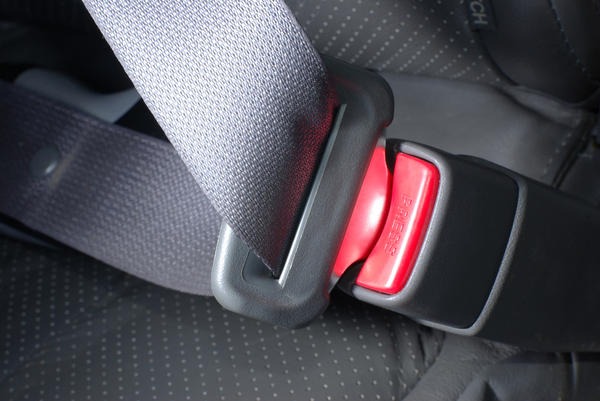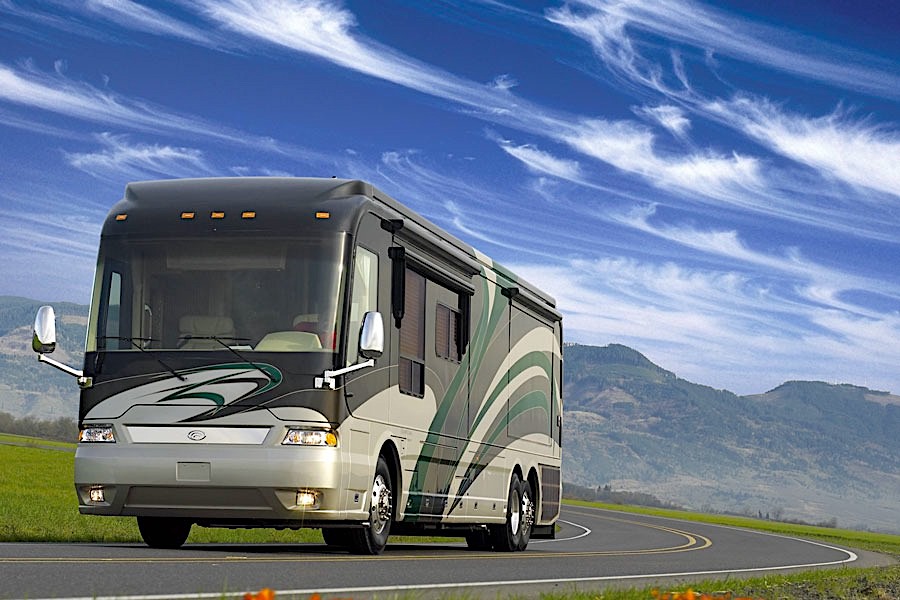Thanks for your support! If you make a purchase using our links in this article, we may make a commission. And, as an Amazon Associate, I earn from qualifying purchases. See the full disclosure here.
Updated April 27, 2024
When you purchase your first RV you will probably be very excited to get inside and experience everything it has to offer. You might even consider staying in the RV and walking around while someone else is driving. Unfortunately, this is very dangerous and illegal in many places, so you should avoid doing this.
Walking around in your RV while someone is driving might not seem like an overly dangerous thing to do. However, you need to remember that you are still in a moving vehicle when you are in an RV. If anything it is more dangerous to be walking around in your RV because it is a larger vehicle than a regular car.
In a car, if you crash you will stay in one spot. However, if you crash while up in your RV, you will be thrown across the room and risk even graver injuries than you would in a regular car crash. As a result, there are laws in place that forbid people from walking around in their RV while driving.
Although there may be some places in the world where there are not laws in place to prevent this kind of activity, you should still stay seated while driving. The laws are in place to protect you, and if you choose to walk around just because it is legal, the only person you are hurting is yourself. If you crash while walking around you could get a serious injury that could impact you for the rest of your life.
- Do Motorhomes Have Seatbelts In The Back?
- Are Seat Belts Required in an RV?
- Is Walking Around in a Class A, B, or C RV While Driving Legal?
- Are Passengers Allowed in Travel Trailers or 5th Wheels While Driving?
- Which States Allow Passengers in a Moving RV?
- Can You Put Car Seats in an RV?
- Can I Install Seat Belts in my RV?
- Final Words About Walking In An RV While Driving
- Related Reading:
- Mike Scarpignato – Bio
Do Motorhomes Have Seatbelts In The Back?
Yes, many motorhomes have seatbelts for passengers in the rear. While there aren’t typical seats in the rear like in the cab, they’re are often belts available.
The belts may be part of a couch or in an eating area. Some B Class RVs have a third seat in the back so you’ll have a standard vehicle seat for a passenger. In the case of Class A and C RVs, it’s not common to have captain chair-style seats in the rear.
Are Seat Belts Required in an RV?
Seat belt laws vary from state to state. However, every state has laws that require the people in the front seats to wear their seat belts. That being said, there are 28 states that have no further restrictions in regard to seat belts. This means that in those 28 states, only the people in the front seats need to wear a seat belt.
Conversely, the other 22 states require that all passengers in the RV have their seat belts on while the RV is in motion. There are no exceptions, so if you are in a moving RV in one of those 22 states, you need to find a seat with a seat belt.
Additionally, some of the states that do not require seat belts for sitting in the back do still require them for young children. 26 of those 28 states have laws that require minors of a certain age range to wear seat belts.
Regardless of the laws in your state, it is a good idea to wear a seat belt while your RV is in motion. Just because it is legal in your state does not mean that it is any less dangerous. Riding in an RV without a seat belt is still incredibly dangerous. It could result in serious injury or even death in the event of a crash. So, stay safe and wear your seat belt.
Is Walking Around in a Class A, B, or C RV While Driving Legal?
Class A, B, and C motorhomes are the only RVs that allow passengers to ride in the back of the RV while driving. However, that does not mean that you should be walking around while the RV is in motion.
Although there are not laws in every state that explicitly ban walking around in your RV. However, that does not mean you should be doing it. Many states require you to be wearing a seat belt at all times, and in those states, you are obviously not allowed to walk around in the RV.
However, for the states that do not require a seat belt while sitting in the back, it is still a good idea to remain seated.
Walking around in your RV will put you at serious risk for a severe injury. It could even result in a fatality. Not only that but moving around in the back of the RV has the potential to distract the driver.
So, you are putting yourself at risk by distracting the driver while you are in a vulnerable position, and you are putting everyone else in the vehicle at risk. So, do not be selfish, sit down and wear your seat belt.
Are Passengers Allowed in Travel Trailers or 5th Wheels While Driving?
As is the case with most RV laws in the United States, the legality around riding in travel trailers and 5th wheels while driving varies from state to state. In many states, it is not legal and you can only ride in the front seat. As a result, you may need people to follow you in their car so that they can come on a trip with you and sleep in the trailer.
However, there are some states that allow passengers to ride in a travel trailer or 5th wheel while driving. Some allow both, while some states only allow passengers to ride in 5th wheels.
Furthermore, there are many states that only allow passengers to ride in travel trailers and 5th wheels when there is a two-way communication device between the driver and passenger.
With all that said, it is always a good idea to check the RV laws in your state before doing anything questionable. Laws can vary greatly from state to state, so it is a good idea to stay on top of things.
Which States Allow Passengers in a Moving RV?
The laws around staying in a moving RV vary from state to state. There are also many different types of RVs. So, some states allow you to ride in some RVs but not in others.
Truck campers are by far the type of RV where it is legal to ride in them in most states. It is legal in Alabama, Alaska, Arizona, California, Colorado, Connecticut, Delaware, Florida, Georgia, Hawaii, Idaho, Illinois, Indiana, Iowa, Kansas, Kentucky, Louisiana, Maryland, Massachusetts, Michigan, Minnesota, Mississippi, Missouri, Montana, Nebraska, Nevada, New Jersey, New Mexico, New York, North Carolina, North Dakota, Ohio, Oklahoma, Oregon, Rhode Island, South Dakota, Tennessee, Texas, Utah, Vermont, Virginia, Washington, West Virginia, and Wyoming. As you can see it is legal in the vast majority of states, However in some states there are age restrictions.
Riding in travel trailers is legal in far fewer states. It is legal in Arizona, Indiana, Iowa, Kansas, Maryland, Michigan, Minnesota, Mississippi, Missouri, Nebraska, and North Carolina. There are also age restrictions in place in some states.
Finally, there are 5th-wheel trailers which fall somewhere in the middle in terms of legality. Riding in them is legal in, Arizona, California, Indiana, Iowa, Kansas, Maryland, Michigan, Minnesota, Mississippi, Missouri, Montana, Nebraska, New Jersey, New York, North Carolina, North Dakota, Oregon, Pennsylvania, South Carolina, South Dakota, Tennessee, West Virginia, and Wisconsin. There are age restrictions in place in some states as well.
You should note that there are laws in some states that require there to be a two-way communication device between the driver and passenger. So, if you do not have one you cannot have passengers in the back of your RV in those states. The National Highway Traffic Safety Administration is a very good source for checking seat belt laws in every state.
Can You Put Car Seats in an RV?

RVs are exempt from state car seat laws in many states. However, that does not mean that you should not be taking the proper precautions with your children. If you have small children, you may want to install a car seat. However, that might not be possible depending on the type of RV you have.
Some RVs are not equipped to handle the installation of a child car seat. However, in the ones that do, you will need to find a seat that fits. Car seats are more complicated to install in RVs than in cars because they are not always built to accommodate car seats.
When you go to install a car seat, it is important to find a seat that is front-facing. Seats that are not front-facing are far more dangerous, and as a result, you do not want to put your child in that position.
In most RVs, the best place to put your car seat is in the front seat next to the driver. A lot of the time this is the only front-facing seat in an RV other than the driver’s seat. As a result, you will want to pick this seat to install your car seat.
With all that said, car seats are not built for the big seats that exist in RVs. As a result, it may be better to bring a car with you on your trip if you are bringing a child with you. This way you can drive the child to your destination in your car. Your child will be safe, and you can still have the trip you planned. All that changes is the travel.
Can I Install Seat Belts in my RV?

Yes, it is legal and recommended in most states for you to install seat belts on the back of your RV if you plan on having passengers ride with you. However, you need to make sure that you purchase seat belts that have passed Federal Motor Vehicle Safety Standards.
Many of the seat belts that are available for you to purchase are going to be three-point retractable seat belts. These are some of the best options for you because they are easy to install. They also do a great job of restraining any adult passenger when the vehicle is in motion.
Final Words About Walking In An RV While Driving
After reading, we hope you have a better idea of what the laws look like around seat belts and walking in an RV while driving. Walking around is illegal in most states, and in the ones where it is legal, it is still a bad idea. Seat belts are required in around half the states in the United States. However, many of the other states have laws that always require minors to wear seat belts.
The most important thing for you to do before you start traveling in your RV is to check the laws and regulations in your state. Like many things in the United States, laws vary drastically from state to state.
Something that is legal in Arizona might be illegal in Florida. Since there are 50 states, you can see how things could get a little complicated if we tried to explain the laws for each state. So, you need to go and familiarize yourself with the laws in your state.
It is also important to know the laws of surrounding states because there is a good chance you will travel outside your state for a trip. So, if you plan on traveling outside your state, you need to know the laws of every state you travel through.
Going on a vacation in your RV can be very enjoyable and a great bonding experience for friends and family. However, for any of that bonding to take place, you need to make sure you are safe and doing everything legally. So, buckle up and travel safe.
Are you a new or experienced RV owner? What state do you live in and what are the laws like there? Would you wear a seat belt in a state where it is not required? Let us know in the comments!
Related Reading:
– Can I Legally Ride In A Travel Trailer?
– Is it Legal to Ride In a Truck Camper or 5th Wheel?
– Is it Safe To Leave a Pet in an RV?
– When is it Too Windy to Drive an RV?
Mike Scarpignato – Bio
Mike Scarpignato created RVBlogger.com over five years ago in 2018 to share all we have learned about RV camping.
Mike is an avid outdoorsman with decades of experience tent camping and traveling in his 2008 Gulf Stream Conquest Class C RV and 2021 Thor Challenger Class A motorhome.
We attend RV Shows and visit RV dealerships all across the country to tour and review drivable motorhomes and towable trailers to provide the best evaluations of these RVs in our blog articles and YouTube videos.
We are 3/4-time RVers who created RVBlogger.com to provide helpful information about all kinds of RVs and related products, gear, camping memberships, tips, hacks and advice.



